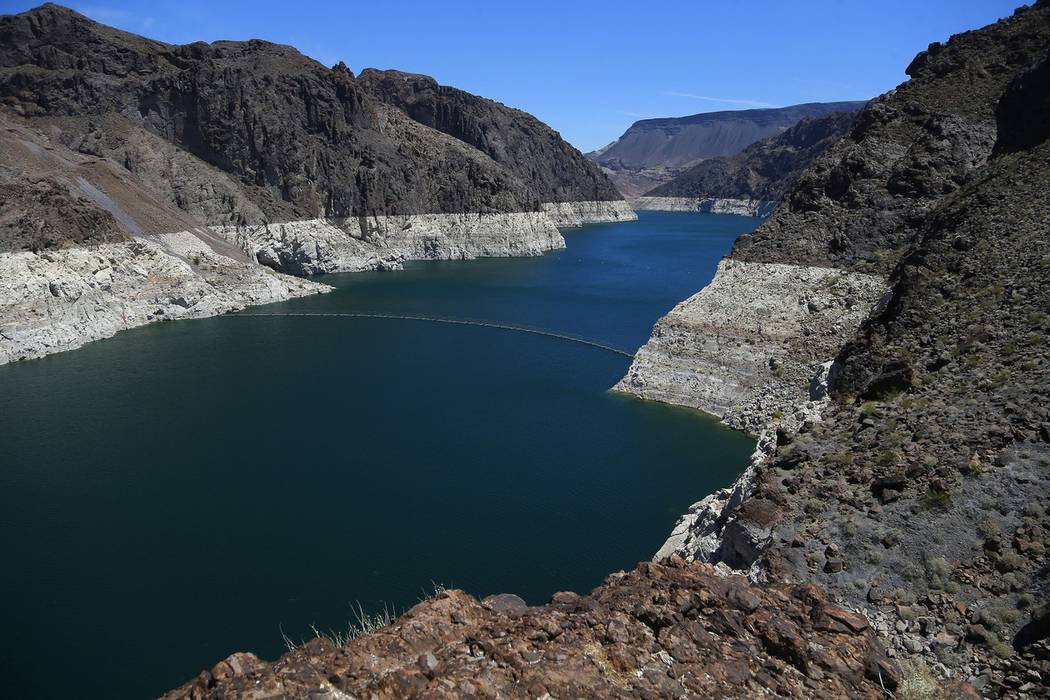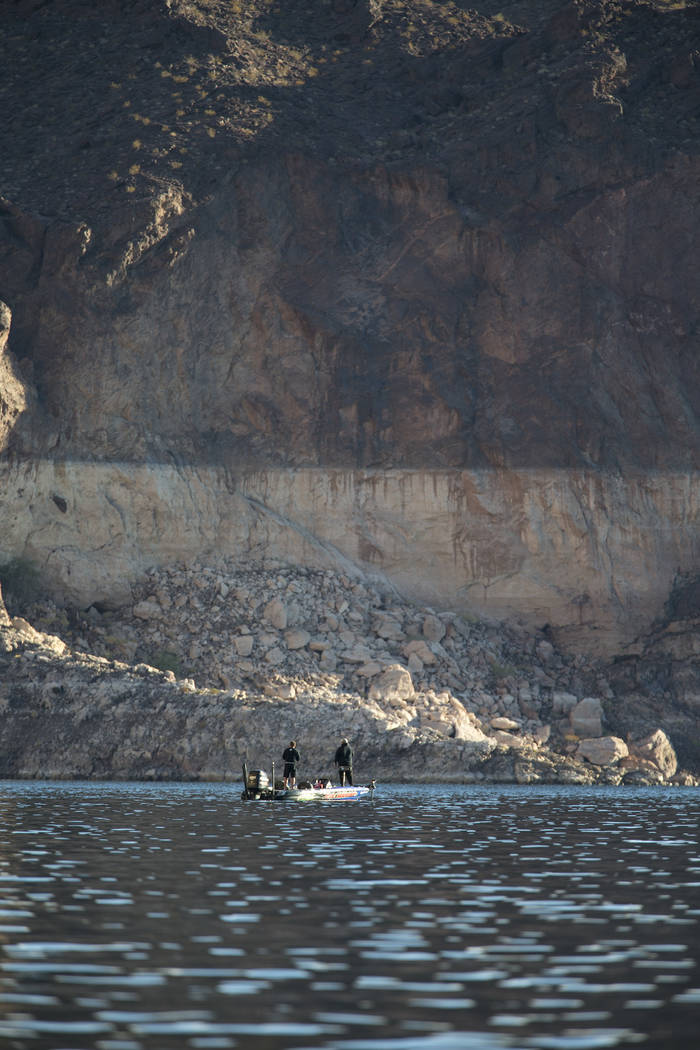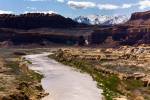Colorado River states wrap up emergency drought plan
The seven Colorado River states finished their emergency drought plan just ahead of a federal deadline, but the completed deal signed in Arizona on Tuesday excludes the river’s largest water user.
California will participate in the plan without the Imperial Irrigation District, which draws more water from the river than any other entity but is refusing to sign the pact because it doesn’t address the growing environmental threat posed by the shrinking Salton Sea.
Southern Nevada Water Authority chief John Entsminger and other representatives of the seven states gathered Tuesday afternoon in Phoenix to sign a letter to Congress requesting federal legislation enacting the Drought Contingency Plans negotiated by the states over the past four years.
In a statement, the water authority said the commitments made by water users will help preserve the health of the river system and protect water supplies across the basin.
“With nearly two decades of severe drought conditions on the Colorado River and continuing uncertainty associated with climate change, the critical importance of the (Drought Contingency Plans) cannot be understated,” the statement said.
In a news conference after the signing, U.S. Bureau of Reclamation Commissioner Brenda Burman confirmed that the “hard work is done.”
“I commend the basin states and key water contractors on the completion of this historic milestone,” she said.
Cuts and more cuts
Earlier this year, after several previous deadlines had come and gone, she gave the states until March 19 to reach a deal or face possible water curtailments as part of a federal drought response she vowed to impose by August.
The now-completed plans call for Nevada, Arizona and, eventually, California to voluntarily reduce river use and leave more water in Lake Mead, while Colorado, New Mexico, Utah and Wyoming send more water downstream to prop up Lake Powell and protect hydropower generation at Glen Canyon Dam.
Under the first round of annual reductions, which could start in January, Arizona would give up 192,000 acre-feet of water. Nevada would give up 8,000 acre-feet, enough to supply about 16,000 average valley homes for just over a year.
Mexico agreed to its own set of drought cuts under a separate deal struck in 2017.
California would join in the voluntary cuts only if Lake Mead’s water level drops another 45 feet from where it is now.
The Imperial Irrigation District won’t be forgoing any water. Board members for the massive agricultural water district met behind closed doors Monday and emerged defiant. They said they would not join any deal that excludes funding to address the unfolding crisis at California’s largest lake.
In a statement, board President Erik Ortega said his organization “stands with the Salton Sea, even when no one else will.”
The shallow, briny lake is replenished with agricultural runoff, but recent changes in water allocations are expected to speed its decline, increasing the salt content of the water and fouling the air in nearby communities with blowing dust from the dry lake bed.
Siding with the sea
In December, Imperial board members announced they wouldn’t support the Colorado River drought plan without $200 million in federal matching funds to help implement California’s 10-year plan to stabilize the Salton Sea.
Ortega said Monday that by moving ahead without Imperial, “what the other parties are saying is that a plan that eliminates the river’s largest single water user and ignores the environmental challenges posed by the Salton Sea still checks all the other boxes for them. … What they’re also saying is that getting the (Drought Contingency Plans) done is more important than getting it right.”
Peter Nelson, chairman of the Colorado River Board of California, said Tuesday in Phoenix that everyone would have been better off if Imperial chose to participate in the final deal. But he stressed that the drought plan for the Colorado won’t take any water away from the Salton Sea.
The Metropolitan Water District of Southern California, the state’s largest municipal purveyor, has agreed to take on Imperial’s share of any drought cuts California might have to absorb.
In its statement Tuesday, the Southern Nevada Water Authority called Imperial’s stance “shortsighted, manipulative and simply not supported by any reasonable view of the facts.”
Headed for the Hill
The escalating series of voluntary cuts outlined in the drought plan are designed to slow the decline of Lakes Mead and Powell, which have seen their combined storage dip below 45 percent amid 20 years of record drought on the overtaxed Colorado.
Water users in Nevada and Arizona have been bracing for additional mandatory cuts next year, as Lake Mead shrinks toward the trigger point for a first-ever federal shortage declaration. Forecasters now expect the reservoir to stay safely above the shortage line for at least another year, thanks to above-average snowfall in the mountains that feed the river system.
The Las Vegas Valley draws about 90 percent of its water supply from the Colorado by way of Lake Mead.
It’s now up to Congress to finalize the drought plans so they can be enacted this year, something Burman is hopeful can be done swiftly.
She said hearings have already been scheduled in the House and Senate next week, as work starts to advance the necessary legislation.
Contact Henry Brean at hbrean@reviewjournal.com or 702-383-0350. Follow @RefriedBrean on Twitter.
At a glance
The emergency drought plan signed Tuesday spells out an escalating series of voluntary water cuts aimed at protecting the river's two largest reservoirs through 2026. Starting as early as January, Nevada, Arizona and, eventually, California will reduce their river use and leave more water in Lake Mead, while Colorado, New Mexico, Utah and Wyoming will send more water downstream to prop up Lake Powell.
The overall plan requires federal legislation to be enacted.
Mexico will also make voluntary cuts under a separate agreement reached in 2017.
What it means for Nevada:
The Silver State has agreed to voluntary annual cuts, based on the water level in Lake Mead, that start at 8,000 acre-feet a year and increase to 10,000 acre-feet. That is enough water to supply roughly 20,000 average valley homes for a little over a year.
What it means for valley residents:
Southern Nevada Water Authority officials have said local water customers won't be impacted by these cuts or other, mandatory ones that are expected in the event of a shortage on the Colorado River. The valley has reduced its overall water use enough since 2002 to easily absorb any anticipated cuts. New infrastructure nearing completion at Lake Mead will allow the authority to keep delivering the community's full allotment of river water no matter how low the lake gets.





























